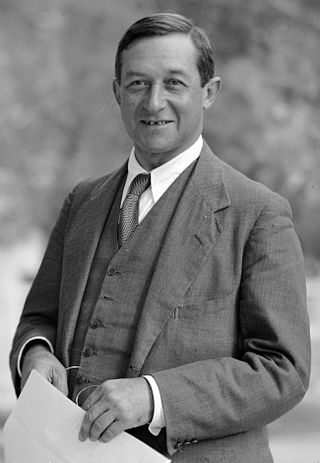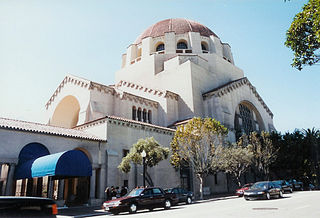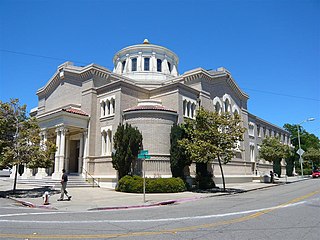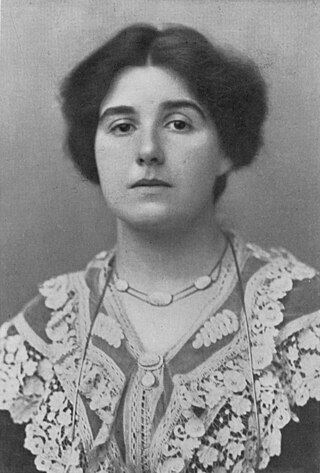Biography
Frank was the daughter of Polish immigrants, Bernard and Leah Frank. As a young woman, Frank taught Bible studies and Jewish history at the First Hebrew Congregation of Oakland's Sabbath school, [1] where she began to hone her skills as a public speaker and make a name for herself within the California Jewish community. Her students included Gertrude Stein, later to become a famous writer, and Judah Leon Magnes, who would become a prominent Reform rabbi. [2] At the same time, Frank worked as a correspondent for several San Francisco and Oakland newspapers and was a frequent contributor to a number of national Jewish publications.
On September 14, 1890, Frank gave the Rosh Hashanah sermon for a community in Spokane, Washington, thus becoming the first woman to preach from a synagogue pulpit, although she was not a rabbi. [3] The impassioned sermon she delivered made a deep impression on the audience made up of townspeople- Christians as well as Jews, beginning a career as "the Girl Rabbi of the Golden West" that would help to blaze new paths for women in Judaism. Despite the fact that Frank claimed to have no interest in becoming a rabbi, her actions forced American Jewry to consider the possibility of the ordination of women seriously for the first time.
As a result, Frank spent much of the 1890s traveling up and down the West coast giving lectures to B'nai B'rith lodges, literary societies, and synagogue women's groups, speaking in both Reform and Orthodox synagogues, giving sermons, officiating at services, and even reading Scripture. Although headlines began to refer to Frank, incorrectly, as the first woman rabbi, and she was reportedly offered several pulpits, Frank insisted that she had never had any desire for ordination.
In 1893, The Register-Guard , a newspaper based in Oregon, reported that "Miss Ray Frank, a highly educated young woman from Oakland, Cal., is about to study for the Jewish pulpit." [4]
The newness of the Jewish communities in the West likely contributed significantly to Frank's ability to do what she did. Had more established Jewish institutions and a well-entrenched Jewish leadership existed on the West Coast, Frank might never have been given the opportunity to preach. By occupying the pulpit temporarily, Frank opened the door, however slightly, for Jewish women's long journey towards public religious leadership.
A rabbi is a spiritual leader or religious teacher in Judaism. One becomes a rabbi by being ordained by another rabbi—known as semikha—following a course of study of Jewish history and texts such as the Talmud. The basic form of the rabbi developed in the Pharisaic and Talmudic eras, when learned teachers assembled to codify Judaism's written and oral laws. The title "rabbi" was first used in the first century CE. In more recent centuries, the duties of a rabbi became increasingly influenced by the duties of the Protestant Christian minister, hence the title "pulpit rabbis", and in 19th-century Germany and the United States rabbinic activities including sermons, pastoral counseling, and representing the community to the outside, all increased in importance.

The Hebrew Union College – Jewish Institute of Religion is a Jewish seminary with three locations in the United States and one location in Jerusalem. It is the oldest extant Jewish seminary in the Americas and the main seminary for training rabbis, cantors, educators and communal workers in Reform Judaism. HUC-JIR has campuses in Cincinnati, Ohio, New York City, Los Angeles, and Jerusalem. The Jerusalem campus is the only seminary in Israel for training Reform Jewish clergy.
The Jewish Institute of Religion was an educational establishment created by Rabbi Stephen S. Wise in 1922 in New York City. While generally incorporating Reform Judaism, it was separate from the previously established Hebrew Union College. It sought to train rabbis "for the Jewish ministry, research, and community service." Students were to serve either Reform or traditional pulpits.

The Magnes Collection of Jewish Art and Life, formerly known as the Judah L. Magnes Museum from 1961 until its reopening in 2012, is a museum of Jewish history, art, and culture in Berkeley, California. The museum, which was founded in 1961 by Seymour and Rebecca Fromer, is named for Jewish activist Rabbi Judah L. Magnes, a native of Oakland and co-founder of the Hebrew University of Jerusalem. The Magnes Collection of Jewish Art and Life houses more than 30,000 Jewish artifacts and manuscripts, which is the third largest collection of its kind in the United States.

Judah Leon Magnes was a prominent Reform rabbi in both the United States and Mandatory Palestine. He is best remembered as a leader in the pacifist movement of the World War I period, his advocacy of a binational Jewish-Arab state in Palestine, and as one of the most widely recognized voices of 20th century American Reform Judaism. Magnes served as the first chancellor of the Hebrew University of Jerusalem (1925), and later as its President (1935–1948).

Congregation Emanu-El of San Francisco, California is one of the two oldest Jewish congregations in California, and one of the largest Jewish congregations in the United States. A member of the Union for Reform Judaism, Congregation Emanu-El is a significant gathering place for the Bay Area Jewish community.

Temple Sinai is a Reform Jewish congregation and synagogue located at 2808 Summit Street in Oakland, California, in the United States. Founded in 1875, it is the oldest Jewish congregation in the East San Francisco Bay region.
Congregation Beth Israel is a Modern Orthodox synagogue in Berkeley, California, in the United States. Established in 1924 as the Berkeley Hebrew Center, it traces its origins to the First Hebrew Congregation of Berkeley, founded in 1909. It was Berkeley's first synagogue and remains its oldest. Lay-led for four decades, it hired its first rabbi, Saul Berman, in 1963.
Congregation Am Tikvah is a combined Conservative and Reform Jewish congregation and synagogue located at 625 Brotherhood Way in San Francisco, California, in the United States. The congregation was formed in 2021 as the result of the merger of the Conservative B'nai Emunah and the Reform Beth Israel Judea congregations, with the latter formed in 1969 through a merger of the Conservative Congregation Beth Israel and the Reform Temple Judea. The congregation is affiliated with both the Union for Reform Judaism and the United Synagogue of Conservative Judaism.

Women rabbis and Torah scholars are individual Jewish women who are recognized for their studies of the Jewish religious tradition and often combine their study with rabbinical ordination. Ordination of women has grown since the 1970s with over 1,200 Jewish women receiving formal ordination. The majority of these women are associated with Progressive Jewish denominations. In Orthodox Judaism, the matter of ordination is more complex. Although a significant number of Orthodox women have been ordained as rabbis, many major Orthodox Jewish communities and institutions do not accept the change. In an alternative approach, other Orthodox Jewish institutions train women for various Jewish religious leadership roles and may entail training in Jewish Law although no formal rabbinic ordination is granted. Instead, alternate titles are used. Yet, despite this alteration in title, these women are often perceived as equivalent to ordained rabbis.
The first openly lesbian, gay, bisexual, and transgender clergy in Judaism were ordained as rabbis and/or cantors in the second half of the 20th century.
Joseph Asher (1921–1990) was an American rabbi born in Germany, known for his advocacy of reconciliation between the Jews and the Germans in the post-Holocaust era, and for his support for the civil rights movement in the United States. He was senior rabbi at Congregation Emanu-El in San Francisco for 19 years.

Congregation Sherith Israel is a Reform Jewish congregation and synagogue, located in San Francisco, California, in the United States. Founded in 1851 during California’s Gold Rush period, it is one of the oldest synagogues in the United States. In more modern times, the congregation widely known for its innovative approach to worship and lifecycle celebrations. Listed on the National Register of Historic Places, its historic sanctuary building, completed in 1905, is one of San Francisco's most prominent architectural landmarks.

Fred Rosenbaum is an American author, historian and adult educator, specializing in the history of the Jewish community of the San Francisco Bay Area. Rosenbaum has been called a "superb storyteller". He is a founder and the director of Lehrhaus Judaica in Berkeley, California, described as "the largest Jewish adult education center in the western United States".

Martha Neumark (1904–1981) was a notable early figure in the history of women's ordination as rabbis. Neumark was widely reported to be the first Jewish woman to be accepted into a rabbinical school.

Tehilla Lichtenstein, born Tehilla Hirshenson, was a leader of Jewish Science, as well as an author. She was born in Jerusalem and immigrated to America when she was eleven years old. Her parents were Hava (Cohen) and Rabbi Chaim Hirschensohn. She earned a B.A. degree in Classics from Hunter College and an M.A. degree in literature from Columbia University.

Louis Israel Newman, was an American Reform rabbi, and author. While working in New York City, Newman later became a member of the Zionist Revisionist movement. He worked as a rabbi in San Francisco, Berkeley, New York City, and Waltham, Massachusetts. Newman was known for his progressive views, his involvement in the Zionist Revisionist movement, and his prolific writing, which included books on Jewish history, theology, and identity.

Pauline Ruth "Nina" Salaman was a British Jewish poet, translator, and social activist. Besides her original poetry, she is best known for her English translations of medieval Hebrew verse—especially of the poems of Judah Halevi—which she began publishing at the age of 16.

The history of the Jews in San Francisco began with the California Gold Rush in the second half of the 19th-century.















